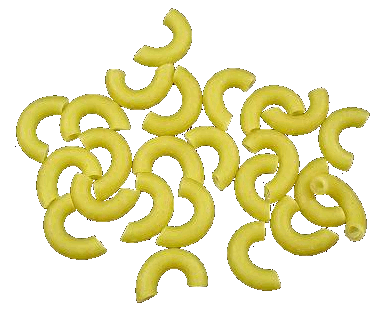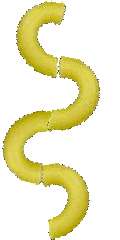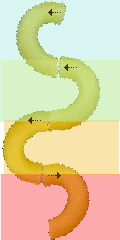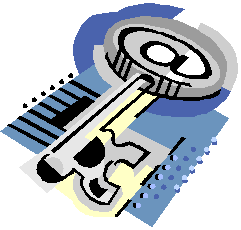Now, for those of you who already know how many curves
are in your back, you already know the answer - shh!
For folks who haven't thought of this lately (or ever) or
haven't seen a picture lately (or ever), check it out on
your own body. Start at your tail and travel up your
spine, through the small of your back, to maybe the last rib
or two. Then reach over your shoulders and from
between your shoulder blades travel up to the base of your
skull.
- How many curves did you feel?
- Can you figure out where each curve starts and each
curve ends?
- Can you put the top of the curve over the bottom of
the curve? (go for the center of the bones over
each other.)
- Can you find the places where the curves switch, ie
from back to front or front to back, and line those up?
Want a peek
at a human spine? The thing about anatomical
drawings and real backs is that it's a little bit hard to
find 'ideal' representations -- they're real, all right,
along with what usually happens to real backs, which usually
isn't lovely. But
this is a rather pretty picture and it illustrates where the
curves are and how many of them there are.
Once you figure out how many curves there are, the next
trick is to get them stacked up.
This is not a physical thing you do. It's a mental
thing. The 'left' brain, which is lingual, cannot move
the body. It can talk, but it can't 'do.' Because
it can talk and observe, it can ask questions and give
feedback. For instance, it can say 'would it be
possible for the top of my sacrum to line up over the tip of
my tailbone?' and it can then watch or feel to see if this
is happening and provide feedback such as 'the top of my
sacrum is behind the tip of my tailbone.' Or it
can say something like 'the top of my sacrum is in front of
and to the right of the tip of my tailbone.' You would
continue asking the question ''would it be possible for the
top of my sacrum to line up over the tip of my tailbone?'
and watching or feeling until the answer you get is 'Yes!'
You might be wondering, 'How does this work?' The
'right' brain is connected to the body and moving the body
parts for you in a very efficient manner, only it can't talk
to you about how it's doing it or say that it's doing it or
anything like that. It can show you how it's doing it
and then the left brain can verbalize it and provide
feedback. In this manner, both halves of the brain are
working together.
If you were to say to yourself, 'I need to move my lower
back forward' and then intentionally move it, it won't
work nearly as well as the 'right' brain ability has been
hijacked by the 'left' brain.
Now that the curves are stacked up with the tops over the
bottoms and the transition places on top of each other, you
will notice a spiffy thing. There's a
line! Now that you're familiar with your back
and how to converse with it, you can ask it, 'Hey -- can you
but the tops and the bottoms of the curves on a straight
plumb line?' And viola! Now
you'll notice something spiffy in your riding!
This is something you can try out as you read this,
sitting at a light or standing in line, or while you're
walking or running or swimming. When you're riding,
play with it the first five minutes or so while you're
warming up at the walk. Check in on it again when you
pick up the trot. Can you find it at the canter?
So elbows -- what have they got to do with it? Sometimes it's easier to see a real spine and sometimes
it isn't. Sometimes it's easier just to see macaroni
elbows and watch them rotate in space until the top is over
the bottom. Whatever works best for you is the thing
to do.
Have you had a chance to play with this in your
riding? What is your experience with this?




![Centered Riding Today: An Informal Talk by Sally Swift [VHS]](http://ecx.images-amazon.com/images/I/41Vn6PfhzML._SL125_.jpg)
![Centered Riding with Sally Swift [VHS]](http://ecx.images-amazon.com/images/I/51OSh9kd9iL._SL125_.jpg)


 You might think, "TWO!" Only, the
question really is, "if you used macaroni
elbows to represent all the curves in your spine
from front to back or back to front, how many elbows
would it take?"
You might think, "TWO!" Only, the
question really is, "if you used macaroni
elbows to represent all the curves in your spine
from front to back or back to front, how many elbows
would it take?" 









